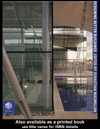- Available Now
- Newly Added Audiobooks
- Nonfiction Audiobooks
- Most Popular Audiobooks
- Try Something Different
- See all
-
Description
-
Creators
-
Details
Eight chapters focus on case studies of exemplary buildings in particular sectors - offices, schools, housing, and hospitals - and explain why and how they came to be designed, and the design qualities they exhibit. Jon Rouse
of CABE offers ten case studies where organisations have deliberately invested in their buildings to demonstrate their belief in good design, as well as to raise their profile and improve staff recruitment and retention. Richard Feilden of Feilden Clegg Bradley presents some exemplary schools and identifies the key factors they share. Terry Wyatt of Hoare Lea & Partners describes the design of three office buildings where concerns for staff comfort, productivity and well-being were used to decide where and what to build. Dickon Robinson of the Peabody Trust uses three affordable-housing projects to show how a bespoke design-led approach extracts the full potential of a site and contributes to a lasting legacy of attractive housing. Paul Wheeler of DEGW discusses the development of the Housing Quality Indicators. Matthew Carmona of University College London examines six urban design projects and identifies the principles that appear to correlate with good urban design. Bryan Lawson of Sheffield University and Susan Francis of the Medical Architecture Research Unit both address medical buildings - Lawson presents two case studies that show hospital patients favour new wards and recover quicker in them, while Francis identifies the qualities necessary to create therapeutic environments.
Four chapters address the processes necessary to achieve design quality. Tony Pollington of the Construction Clients' Confederation discusses the introduction of the Construction Clients Charter - which commits those clients who sign it to continuous improvement in the procurement of buildings. Peter Trebilcock of AMEC presents three case studies about the management of design that illustrate the need for close co-operation between all parties in the construction process, and an appreciation of each others roles and interests. Adrian Leaman & Bill Bordass of Building Use Studies
draw on the findings of post-occupancy evaluations of buildings to recommend design strategies for achieving flexible and adaptable buildings that accommodate changing requirements and are robust in use. Giles Oliver of Penoyre & Prasad identifies what support design needs to establish a common language for valuing design within the built environment.
Finally three chapters discuss the issue of whether and how design quality can be measured. Sunand Prasad of Penoyre & Prasad introduces the ethical and philosophical issues surrounding the measurement of quality. Michael
Dickson of Buro Happold describes the recently-launched Design Quality Indicators, setting out the attributes and their grouping under three headings of functionality, impact and build quality. And...

- Sebastian Macmillan - Editor
- Robin Nicholson - Author of introduction, etc.
OverDrive Read
- ISBN: 0203337077
- Release date: July 27, 2004
PDF ebook
- ISBN: 0203337077
- File size: 16765 KB
- Release date: July 27, 2004
